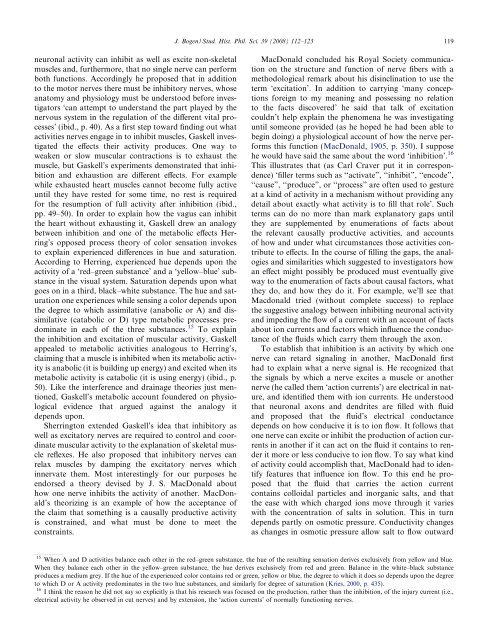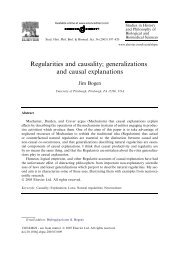Bogen-08-Causally-productive-activities
Create successful ePaper yourself
Turn your PDF publications into a flip-book with our unique Google optimized e-Paper software.
J. <strong>Bogen</strong> / Stud. Hist. Phil. Sci. 39 (20<strong>08</strong>) 112–123 119<br />
neuronal activity can inhibit as well as excite non-skeletal<br />
muscles and, furthermore, that no single nerve can perform<br />
both functions. Accordingly he proposed that in addition<br />
to the motor nerves there must be inhibitory nerves, whose<br />
anatomy and physiology must be understood before investigators<br />
‘can attempt to understand the part played by the<br />
nervous system in the regulation of the different vital processes’<br />
(ibid., p. 40). As a first step toward finding out what<br />
<strong>activities</strong> nerves engage in to inhibit muscles, Gaskell investigated<br />
the effects their activity produces. One way to<br />
weaken or slow muscular contractions is to exhaust the<br />
muscle, but Gaskell’s experiments demonstrated that inhibition<br />
and exhaustion are different effects. For example<br />
while exhausted heart muscles cannot become fully active<br />
until they have rested for some time, no rest is required<br />
for the resumption of full activity after inhibition (ibid.,<br />
pp. 49–50). In order to explain how the vagus can inhibit<br />
the heart without exhausting it, Gaskell drew an analogy<br />
between inhibition and one of the metabolic effects Herring’s<br />
opposed process theory of color sensation invokes<br />
to explain experienced differences in hue and saturation.<br />
According to Herring, experienced hue depends upon the<br />
activity of a ‘red–green substance’ and a ‘yellow–blue’ substance<br />
in the visual system. Saturation depends upon what<br />
goes on in a third, black–white substance. The hue and saturation<br />
one experiences while sensing a color depends upon<br />
the degree to which assimilative (anabolic or A) and dissimilative<br />
(catabolic or D) type metabolic processes predominate<br />
in each of the three substances. 15 To explain<br />
the inhibition and excitation of muscular activity, Gaskell<br />
appealed to metabolic <strong>activities</strong> analogous to Herring’s,<br />
claiming that a muscle is inhibited when its metabolic activity<br />
is anabolic (it is building up energy) and excited when its<br />
metabolic activity is catabolic (it is using energy) (ibid., p.<br />
50). Like the interference and drainage theories just mentioned,<br />
Gaskell’s metabolic account foundered on physiological<br />
evidence that argued against the analogy it<br />
depends upon.<br />
Sherrington extended Gaskell’s idea that inhibitory as<br />
well as excitatory nerves are required to control and coordinate<br />
muscular activity to the explanation of skeletal muscle<br />
reflexes. He also proposed that inhibitory nerves can<br />
relax muscles by damping the excitatory nerves which<br />
innervate them. Most interestingly for our purposes he<br />
endorsed a theory devised by J. S. MacDonald about<br />
how one nerve inhibits the activity of another. MacDonald’s<br />
theorizing is an example of how the acceptance of<br />
the claim that something is a causally <strong>productive</strong> activity<br />
is constrained, and what must be done to meet the<br />
constraints.<br />
MacDonald concluded his Royal Society communication<br />
on the structure and function of nerve fibers with a<br />
methodological remark about his disinclination to use the<br />
term ‘excitation’. In addition to carrying ‘many conceptions<br />
foreign to my meaning and possessing no relation<br />
to the facts discovered’ he said that talk of excitation<br />
couldn’t help explain the phenomena he was investigating<br />
until someone provided (as he hoped he had been able to<br />
begin doing) a physiological account of how the nerve performs<br />
this function (MacDonald, 1905, p. 350). I suppose<br />
he would have said the same about the word ‘inhibition’. 16<br />
This illustrates that (as Carl Craver put it in correspondence)<br />
‘filler terms such as ‘‘activate”, ‘‘inhibit”, ‘‘encode”,<br />
‘‘cause”, ‘‘produce”, or ‘‘process” are often used to gesture<br />
at a kind of activity in a mechanism without providing any<br />
detail about exactly what activity is to fill that role’. Such<br />
terms can do no more than mark explanatory gaps until<br />
they are supplemented by enumerations of facts about<br />
the relevant causally <strong>productive</strong> <strong>activities</strong>, and accounts<br />
of how and under what circumstances those <strong>activities</strong> contribute<br />
to effects. In the course of filling the gaps, the analogies<br />
and similarities which suggested to investigators how<br />
an effect might possibly be produced must eventually give<br />
way to the enumeration of facts about causal factors, what<br />
they do, and how they do it. For example, we’ll see that<br />
Macdonald tried (without complete success) to replace<br />
the suggestive analogy between inhibiting neuronal activity<br />
and impeding the flow of a current with an account of facts<br />
about ion currents and factors which influence the conductance<br />
of the fluids which carry them through the axon.<br />
To establish that inhibition is an activity by which one<br />
nerve can retard signaling in another, MacDonald first<br />
had to explain what a nerve signal is. He recognized that<br />
the signals by which a nerve excites a muscle or another<br />
nerve (he called them ‘action currents’) are electrical in nature,<br />
and identified them with ion currents. He understood<br />
that neuronal axons and dendrites are filled with fluid<br />
and proposed that the fluid’s electrical conductance<br />
depends on how conducive it is to ion flow. It follows that<br />
one nerve can excite or inhibit the production of action currents<br />
in another if it can act on the fluid it contains to render<br />
it more or less conducive to ion flow. To say what kind<br />
of activity could accomplish that, MacDonald had to identify<br />
features that influence ion flow. To this end he proposed<br />
that the fluid that carries the action current<br />
contains colloidal particles and inorganic salts, and that<br />
the ease with which charged ions move through it varies<br />
with the concentration of salts in solution. This in turn<br />
depends partly on osmotic pressure. Conductivity changes<br />
as changes in osmotic pressure allow salt to flow outward<br />
15 When A and D <strong>activities</strong> balance each other in the red–green substance, the hue of the resulting sensation derives exclusively from yellow and blue.<br />
When they balance each other in the yellow–green substance, the hue derives exclusively from red and green. Balance in the white–black substance<br />
produces a medium grey. If the hue of the experienced color contains red or green, yellow or blue, the degree to which it does so depends upon the degree<br />
to which D or A activity predominates in the two hue substances, and similarly for degree of saturation (Kries, 2000, p. 435).<br />
16 I think the reason he did not say so explicitly is that his research was focused on the production, rather than the inhibition, of the injury current (i.e.,<br />
electrical activity he observed in cut nerves) and by extension, the ‘action currents’ of normally functioning nerves.




